

The Mental Munition Factory: Step-by-step guide to programming the RN-XV WiFi module for Arduino. The Arduino prototyping standard has been around for about 6 years now, and has proven to be immensely useful for sensing devices.
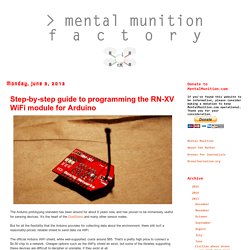
It's the heart of the DustDuino and many other sensor nodes. But for all the flexibility that the Arduino provides for collecting data about the environment, there still isn't a reasonably-priced, reliable shield to send data via WiFi. The official Arduino WiFi shield, while well-supported, costs around $85. That's a pretty high price to connect a $4.50 chip to a network. Cheaper options such as the WiFly shield do exist, but some of the libraries supporting these devices are difficult to decipher or unstable, if they exist at all.
Niltoid.niltoid. The RN-XV WiFly Module from Roving Networks is an affordable way to go wireless with your Arduino project.

It’s $35 and you only need 1 to get started, assuming you have a wi-fi adapter in your computer as well. Previously, only the more expensive options such as the WiFly GSX ($85) were available. I’m not sure, but I assume the price difference is mainly due to signal strength differences. There are currently more resources and Arduino libraries available online for the WiFly GSX or WiFly Sheild, since they’ve been around longer.
Arduino Uno + Wifly RN-XV (Not the shield) After many hours of searching the web, and finding some other people with the same basic problem, I thought I'd share what I found about getting this combination to work using the basic serial communication method.
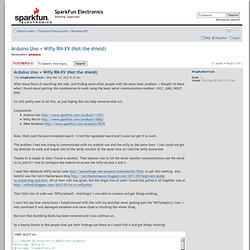
(VCC, GND, DOUT, DIN). I'm still pretty new to all this, so just hoping this can help someone else out. Components Note, that's just the plain breakout board. I tried the regulated board and I could not get it to work. The problem I had was trying to communicate with my arduino uno and the wifly at the same time. Harlequin-tech/WiFlyHQ. Arduinology. Using the WiFly RN-XV from Roving Networks. Hi following on from this post by Chris A.

Using the RN-XV WiFi Module as a Remote Switch. It’s been a struggle, but I finally figured out how to use a Roving Networks RN-XV WiFi module as a remote switch.
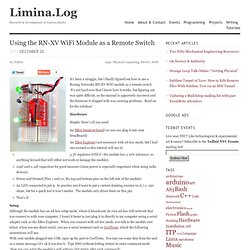
It’s not hard now that I know how it works, but figuring out was quite difficult, as the manual is apparently incorrect and the firmware it shipped with was causing problems. Read on for the solution! Hardware Simple! Here’s all you need: An XBee breakout board (so you can plug it into your breadboard)An XBee Explorer (not necessary with ad-hoc mode, but I had one around so this tutorial will use it)3.3V regulator (ONLY—the module has a 10% tolerance, so anything beyond that will either not work or damage the module).10µF and 0.1µF capacitors for good measure (clean power is especially important when using radio devices)Power and Ground (Pins 1 and 10, the top and bottom pins on the left side of the module)An LED connected to pin 9.
Setup With your module plugged into USB, open up the port in CoolTerm. Cairo Hacker Space: A beginner’s guide to connecting and operating the WiFly to Arduino Serially. We were working on a home automation project , we used the wifly gsx in our project .When we bought it, we thought it will be easy to communicate it like a serial modem between the arduino and PC ,,, of course we are not noobs :) but every inch in the datasheet made us feel like one :)And when we searched for a solution for even one of our countless problems we faced.... the result can be summarized in three words ...
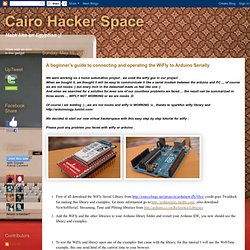
WIFLY NOT WORKING or we are noobs :D Of course i am kidding :) ,,we are not noobs and wifly is WORKING :o , thanks to sparkfun wifly library and We decided to start our new virtual hackerspace with this easy step by step tutorial for wifly :Please post any problem you faced with wifly or arduino . boolean initSettings() WiFly.SendCommand("set wlan auth <value>","AOK"); //WiFly.SendCommand("set wlan key <value>","AOK"); WiFly.SendCommand("set wlan channel <value>","AOK"); WiFly.SendCommand("set wlan join <value>","AOK"); View topic - BlueSmirf Blues. SerialCallResponse. /* Serial Call and Response Language: Wiring/Arduino This program sends an ASCII A (byte of value 65) on startup and repeats that until it gets some data in.

Then it waits for a byte in the serial port, and sends three sensor values whenever it gets a byte in. Thanks to Greg Shakar and Scott Fitzgerald for the improvements The circuit: * potentiometers attached to analog inputs 0 and 1 * pushbutton attached to digital I/O 2 Created 26 Sept. 2005 by Tom Igoe modified 24 April 2012 by Tom Igoe and Scott Fitzgerald This example code is in the public domain. int firstSensor = 0; // first analog sensorint secondSensor = 0; // second analog sensorint thirdSensor = 0; // digital sensorint inByte = 0; // incoming serial byte pinMode(2, INPUT); // digital sensor is on digital pin 2 establishContact(); // send a byte to establish contact until receiver responds } void establishContact() { while (Serial.available() <= 0) { Serial.print('A'); // send a capital A delay(300); }}
Jcrouchley/WiFly-Shield. Getting started with the RN-XV WiFi Module & Node.js. The RN-XV WiFi module is a nifty little WiFi module designed to fit the same pinout as an XBee, so it’s intended to be a drop-in replacement. Tonight I whipped up a little test of the module to get a joystick to talk to a Node.js server over WiFi. I attached +3V power and ground to the module (pins 1 and 10, respectively), pin 2 (TX) to Arduino digital pin 0 (RX), and pin 1 (RX) to Arduino digital pin 1 (TX). That’s all the hardware setup you need. I used this WiFly library to handle the connection. All it does is talk to the WiFly module over serial and send control commands, so the library abstracts that a bit. Print Page - WiFlyHQ: A new library for the WiFly RN-XV. Niltoid.niltoid. Cairo Hacker Space: A beginner’s guide to connecting and operating the WiFly to Arduino Serially. SparkFun WiFly GSX Wireless Ethernet Wifi Breakout. Arduinology. Herbie555 asked: I'm attempting to use WiFlySerial 1.08 with a RN-XV and a Sparkfun ProMicro 3.3V.Wired using the standard pins 2,3, but all my sketches, including WiFlyTest, are hanging at/around the first call to WiFlySerial::begin().
I've checked the wiring continuity and experimented with swapping the pin assignments (3,2 instead) and changing the default baud rate, but I simply cannot get past this first step. 2 RN-XV boards, so I'm reasonably certain it's not a damaged unit. Anything else I can try? Hi Herbie555, WiFlySerial does look for the version number of the RN chip firmware… RN’s send it as part of their command prompt. Set the library’s version number to your RN’s firmware version … might help. Let us know either way! Cheers, SparkFun RN-XV WiFly Module. RN-XV WiFly Module The RN-XV module by Roving Networks is a certified Wi-Fi solution especially designed for customer who want to migrate their existing 802.15.4 architecture to a standard TCP/IP based platform without having to redesign their existing hardware.

In other words, if your project is set up for XBee and you want to move it to a standard WiFi network, you can drop this in the same socket without any other new hardware. The RN-XV module is based upon Roving Networks' robust RN-171 Wi-Fi module and incorporates 802.11 b/g radio, 32 bit processor, TCP/IP stack, real-time clock, crypto accelerator, power management unit and analog sensor interface.The module is pre-loaded with Roving firmware to simplify integration and minimize development time of your application.
In the simplest configuration, the hardware only requires four connections (PWR, TX, RX and GND) to create a wireless data connection. Arduino WiFly Shield from Cool Components. RN-XV WiFly Module - SMA Connector. Description: The RN-XV module by Roving Networks is a certified Wi-Fi solution especially designed for customer who want to migrate their existing 802.15.4 architecture to a standard TCP/IP based platform without having to redesign their existing hardware.
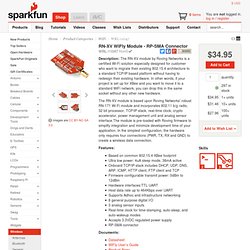
In other words, if your project is set up for XBee and you want to move it to a standard WiFi network, you can drop this in the same socket without any other new hardware. The RN-XV module is based upon Roving Networks' robust RN-171 Wi-Fi module and incorporates 802.11 b/g radio, 32 bit processor, TCP/IP stack, real-time clock, crypto accelerator, power management unit and analog sensor interface.The module is pre-loaded with Roving firmware to simplify integration and minimize development time of your application. In the simplest configuration, the hardware only requires four connections (PWR, TX, RX and GND) to create a wireless data connection. Roving Networks. Arduino Pro Mini with RFM12b. Arduino pro mini + wireless transmitter= good fun!

The previous breakout board I have produced can be used to interface the RFM12b to a controller such as the arduino pro mini. The RFM12b is a single chip, low power, multi-channel FSK transceiver designed for use in applications requiring FCC or ETSI conformance for unlicensed use in the 433, 868 and 915 MHz bands. I have 2 versions of the breakout board: